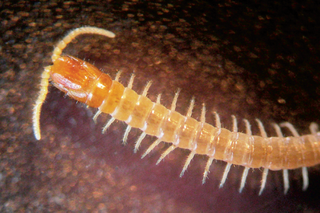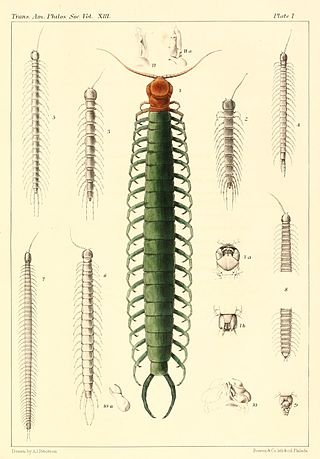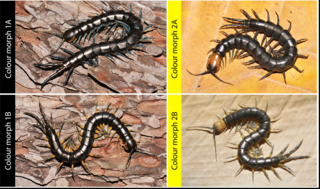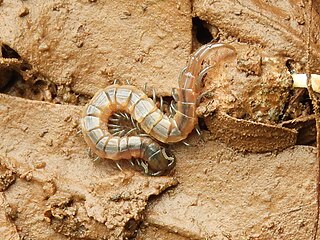
Scolopendridae is a family of large centipedes.

The Scolopendromorpha, also known as tropical centipedes and bark centipedes, are epimorphic. and usually possess 21 or 23 trunk segments with the same number of paired legs. The number of leg pairs is fixed at 21 for most species in this order and fixed at 23 for the remaining species, except for two species with intraspecific variation: Scolopendropsis bahiensis, which has 21 or 23 leg pairs, and Scolopendropsis duplicata, which has 39 or 43 leg pairs. Species in this order have antennae with 17 or more segments. The order comprises the five families Cryptopidae, Scolopendridae, Mimopidae, Scolopocryptopidae, and Plutoniumidae. Nearly all species in the family Scolopendridae have four ocelli on each side of the head, and the genus Mimops features a pale area often considered an ocellus on each side of the head, whereas the other three families are blind. Species in the family Scolopocryptopidae have 23 leg-bearing segments, whereas species in all other families in this order have only 21 leg-bearing segments. The only 3 known amphibious centipedes, Scolopendra cataracta, Scolopendra paradoxa and Scolopendra alcyona belong to this order.

Scolopocryptopidae is a family of blind centipedes. The number of leg-bearing segments is fixed at 23 for species in this family, which distinguishes the species in this family from all other centipede species.

The Geophilidae are a polyphyletic, cosmopolitan family of soil centipedes in the superfamily Geophiloidea containing the mostly defunct clades Aphilodontidae, Dignathodontidae, Linotaeniidae, Chilenophilinae, and Macronicophilidae.

Himantariidae is a monophyletic family of centipedes in the order Geophilomorpha and superfamily Himantarioidea, found almost exclusively in the Northern Hemisphere. The number of leg-bearing segments in this family varies within as well as among species and ranges from 47 to 181. These centipedes are very elongated with a high mean number of trunk segments and great variability in this number within species. The maximum number of legs recorded in this family appears in the species Chomatobius bakeri. The minimum number of legs recorded in this family appears in the species Garriscaphus oreines, This family contains these genera:
Aspidopleres is an African genus of centipedes belonging to the family Oryidae. Centipedes in this genus range from 11 cm to 12 cm in length, have 87 to 105 pairs of legs, and are found in southwest Africa.
Dendrothereua is a genus of house centipedes in the family Scutigeridae. There are at least three described species in Dendrothereua, found in the southern United States and the Neotropics.

Mecistocephalidae is a monophyletic family of centipedes in the order Geophilomorpha. It is the only family in the suborder Placodesmata. Most species in this family live in tropical or subtropical regions, but some occur in temperate regions. This family is the third most diverse in the order Geophiliomorpha, with about 170 species, including about 130 species in the genus Mecistocephalus.

Geophilus is a large, heterogeneous genus of soil centipedes in the family Geophilidae largely considered to be synonymous with Brachygeophilus. It is a mostly holarctic genus characterized by a claw-shaped ultimate pretarsus, anterior porefields, complete or nearly complete coxo-pleural sutures at the prosternum, and incomplete chitin-lines. Centipedes in this genus range from 1 cm to 8 cm in length. The generic name first appeared in Brewster's Edinburgh Encyclopaedia in 1814 as Geophilus electricus.

Plutonium zwierleini, in the monotypic genus Plutonium, is one of the largest scolopendromorph centipedes in Europe, and one of the few potentially harmful to humans. Nevertheless, it has been rarely reported, only from the southern part of the Iberian and Italian peninsulas, Sardinia and Sicily.

Scolopocryptops is a genus of bark centipedes in the family Scolopocryptopidae. There are over 20 described species in Scolopocryptops.

Strigamia is a genus of soil centipedes in the family Linotaeniidae. Members of this family can be identified by their anteriorly tapering bodies, the extra claw on the forcipules, scattered coxal pores, and the distinctly swollen ultimate legs of the males. There are at least 50 described species in Strigamia. Centipedes in this genus can reach 15 cm in length and can have as few as 31 pairs of legs or as many as 83 leg pairs. The species S. hoffmani is notable for its small size as well as for a small number of legs. Other species with notably few legs include S. sibirica and S. lutea.
Agnostrup is a genus of centipedes in the family Mecistocephalidae, native to Europe and Asia. These centipedes range from 2 cm to 3 cm in length. All species in this genus have 41 leg-bearing segments.
Anarrup is a genus of centipedes in the family Mecistocephalidae, native to Europe and Asia as far as Indonesia. These centipedes range from 6 cm to 8 cm in length. All species in this genus have 41 leg-bearing segments.

Ethmostigmus is a genus of centipedes in the family Scolopendridae found in Africa, Asia, and Oceania that is characterised by its large, rounded spiracles.

Ballophilidae is a monophyletic group of centipedes belonging to the order Geophilomorpha and superfamily Himantarioidea. Authorities now dismiss this group as a family, citing phylogenetic analysis, and instead refer to this clade as Ballophilinae, a possible subfamily within the family Schendylidae. The number of legs in this clade varies within species and ranges from 37 to 113 pairs of legs. Two species in this clade can have as few as 37 leg pairs, Ballophilus pallidus and Leucolinum trinidadense, and one species, Ityphilus grandis, can have as many as 113 pairs. Species in this clade tend to have more leg-bearing segments and greater intraspecific variability in this number than generally found in the family Schendylidae.
Diphyonyx is a genus of soil centipedes in the family Geophilidae found in the Palearctic region. They are notable for the unusually shaped claws on the anterior part of the trunk, which are swollen and have anterior spurs enlarged into elongate projections. Centipedes in this genus range from 4 cm to 6 cm in length and have 65 to 81 pairs of legs.

Scolopendra pinguis is a species of centipede in the subfamily Scolopendrinae that is endemic to Southeast Asia.

Arthrorhabdus, from the Greek ἄρθρον, a joint, and ῥάβδος, a staff, is a genus of Scolopendrid centipede in the subfamily Scolopendrinae. Species are found in Mexico and the Southern United States, Australia (A. paucispinus & A. mjöbergi), and South Africa (A. formosus). Since a reapprasial in the genus in 2010, the genus only has four species. It may be polyphyletic.
Gonibregmatus is a genus of centipedes in the family Gonibregmatidae. It was described by British entomologist George Newport in 1843.














